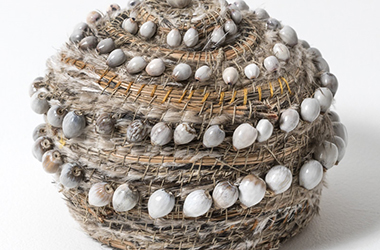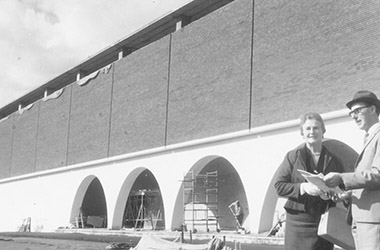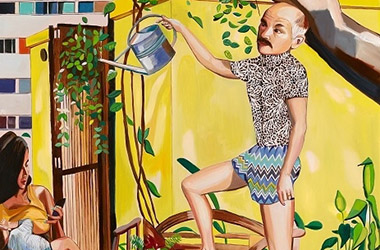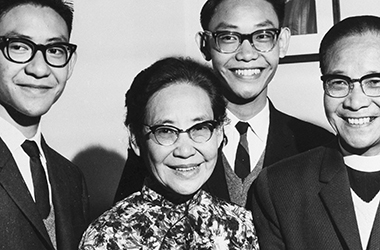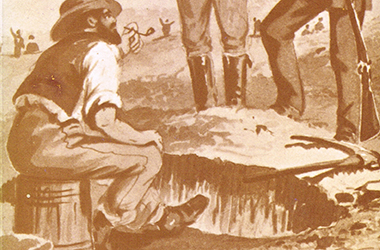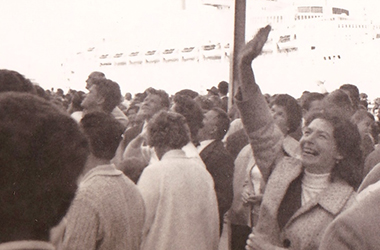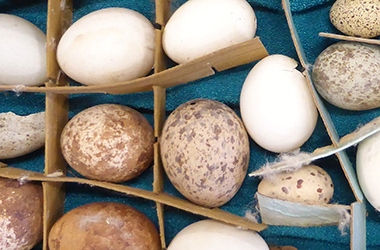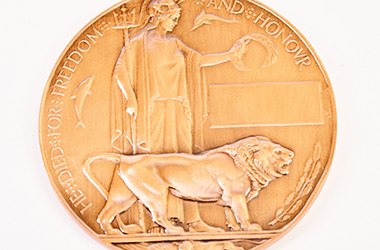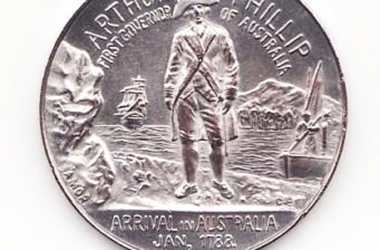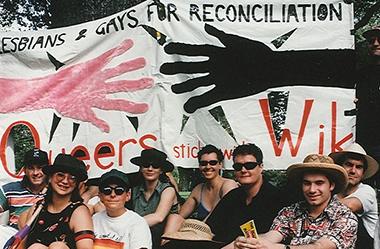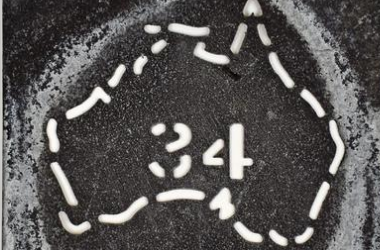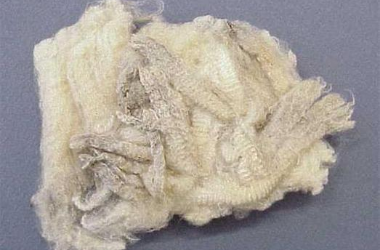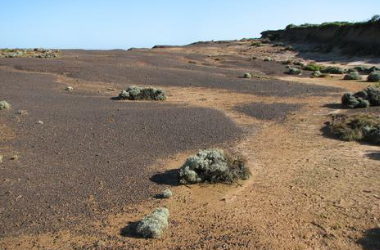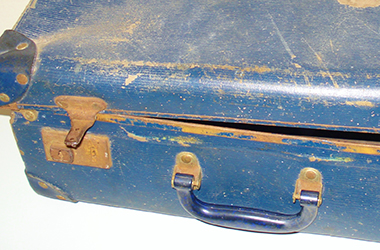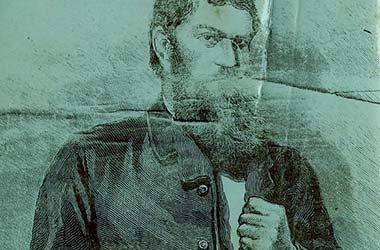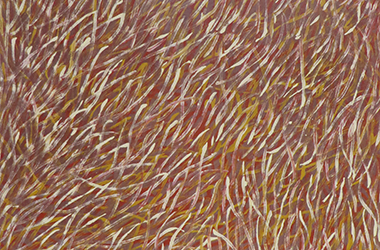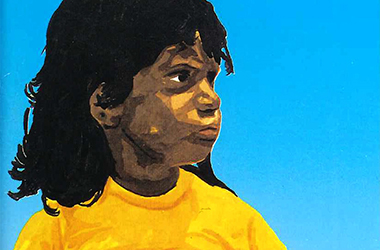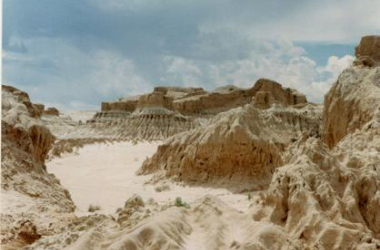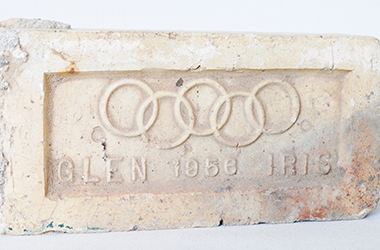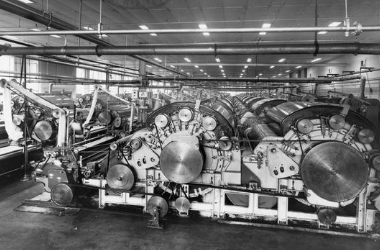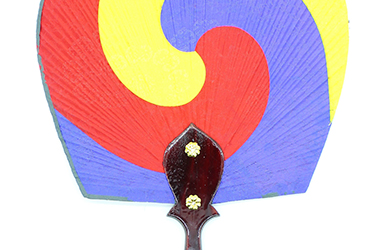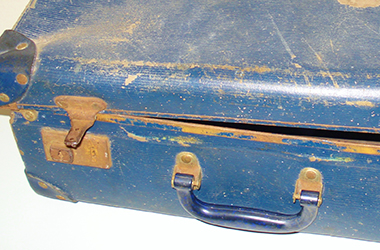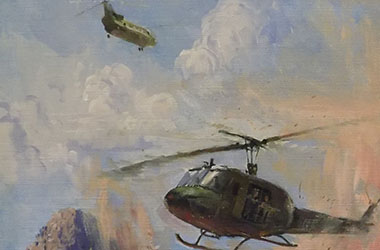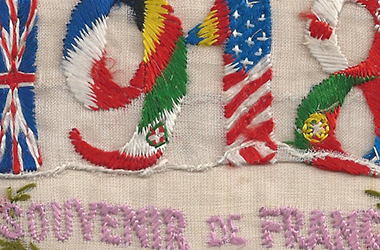Browse stories
-
 Kitty Owens
Kitty OwensAnother Night
Lighting fades away when a lamp is blown out, or when a switch is clicked off, but the history of lighting has left traces in Victorian cultural collections.
This story looks at items and images relating to the history of lighting in Victoria and considers the various lightscapes created by different types of lighting. This story is inspired by the book Black Kettle and Full Moon by Geoffrey Blainey.
After thousands of years of Aboriginal firelight, European households spent their evenings in dim smoky rooms huddled around a spluttering pool of light. Bright lighting was a luxury. As new energy sources and lighting technology became available nights became brighter, extending the day and changing the night time.
-
 Mark S. Holsworth
Mark S. HolsworthArt at Flinders Street Station
The average commuter passing through Flinders Street Station could remain blissfully unaware for their entire lives of anything more artistic in the station than the endless advertising images.
However, as befitting any major public building, there is some commissioned art at Flinders Street Station.
-
 Belinda Ensor
Belinda EnsorAt the Going Down of the Sun
One hundred years on, evidence of the impact of the First World War can be plainly seen across Victoria.
Built heritage including cenotaphs, statues, plaques and obelisks are peppered across the state’s public spaces, each dedicated to the commemoration of the war service of the thousands of Victorians who served between 1914 and 1918.
Many of these men and women died in active service and were buried overseas, so locally built monuments served as important places to mourn and remember them. They were places for private and collective mourning, commemoration and remembrance.
These memorials were truly local, often built through community fundraising and supported by communities who shared a sense of loss. Most are inscribed with the names of those who died from the region, while others list the names of all those who served.
Across Victoria, cenotaphs and built memorials remain central to ANZAC Day services, but the way we commemorate has changed with each generation and so has the way we remember and mourn the servicemen of the First World War. Photographic and material culture collections from across the state, catalogued here on Victorian Collections, capture some of the tangible and intangible heritage associated with the shifting ways we commemorate the First World War. They provide meaningful insight in to our society and how we make sense of war and loss.
-
 Rachael Cottle
Rachael CottleBreaking the Mould: The First Police Women in Victoria
The story of Victoria’s Police Women begins in 1917 when Madge Connor and Elizabeth Beers were appointed as police agents. They had no uniform and were unarmed. Their work was to be similar to that of a social worker; looking after neglected children and protecting vulnerable women.
By 12 November 1924 the number of agents had increased to four; they were sworn into the force as police members. Police women now had powers of arrest and equal pay. However, there were still many challenges ahead for them, including battles for equal opportunities and training.
The onset of World War II saw the role of women change in the work force in Australia. Record numbers of women filled jobs traditionally held by men. Victoria Police faced a shortage of staff due to men enlisting in the war. As a result the Women’s Auxiliary Force was formed in 1942.
Since then, Victorian police women have gone on to many great achievements including: Anne Wregg (nee Cursio) being the first police woman in Australia to be awarded the Queen’s Gallantry Medal for bravery; and Christine Nixon being appointed the first female Chief Commissioner.
In 2017 Victoria Police celebrates 100 years of women in policing. Today women make up a quarter of Victoria’s Police employees. Their struggles and achievements over the last century are acknowledged and celebrated through a new exhibition ‘Agents of Change’ and by the objects and photographs collected and shared by the Victoria Police Museum.
-
 Trevor Smith
Trevor SmithCaptain Wilkinson's Swords
Several months ago we were contacted by Stacey Longstaff from Germany who wanted to donate his ancestor's sword to an appropriate museum in the Portland area.
We put Stacey in touch with the Glenelg Shire Cultural Collection team, who were excited to receive the offer of significant items to add to their collection. Glenelg Shire's Cultural Collection Officer Trevor Smith tells the story...
-
 History Teachers Association of Victoria / Chinese Museum
History Teachers Association of Victoria / Chinese MuseumChinese Anzacs
When World War One was declared, Australia issued a call to arms.
The Chinese-Australian community rallied behind the war efforts. Over two hundred Australians of Chinese descent enlisted. One hundred and seven of these were from Victoria. Of those Chinese Australians who fought, forty-one died. No Chinese-Australian nurses who served in the War have been identified to date.
The story of the Chinese Anzacs is often overlooked in the greater narratives of World War One. Their experiences during and after the war were the subject of the 'Chinese Anzacs' exhibition on display at the Chinese Museum in 2014.
-
 Lauren McAlary
Lauren McAlaryCollecting Fire: A new kind of practice
The fires of February 2009 left an indelible mark on the histories of Victoria’s community collecting organisations; whether through blackened ash markings or by the absence of once cherished objects and ephemera.
This exploration of Victoria’s collecting response to the Black Saturday bushfires is inspired by Liza Dale‐Hallett, Rebecca Carland and Peg Fraser’s reflections on the Victorian Bushfires Collection project, in 'Sites of Trauma: Contemporary Collecting and Natural Disaster'.
-
 Jary Nemo and Lucinda Horrocks
Jary Nemo and Lucinda HorrocksCollections & Climate Change
The world is changing. Change is a natural part of the Earth’s cycle and of the things that live on it, but what we are seeing now is both like and unlike the shifts we have seen before.
Anthropogenic change, meaning change created by humans, is having an impact on a global scale. In particular, human activity has altered the composition of the Earth’s atmosphere, causing the world’s climate to change.
Already in the state of Victoria we are seeing evidence of this change around us. In the natural world, coastal waters are warming and bringing tropical marine species to our bays. Desert animals are migrating to Victoria. Alpine winters are changing, potentially putting plants and animals at risk of starvation and pushing species closer to the margins. In the world of humans, island and coastal dwellers deal with the tangible and intangible impacts of loss as sea levels rise, bush dwellers live with an increased risk of life-threatening fires, farmers cope with the new normal of longer droughts, and we all face extreme weather events and the impacts of social and economic change.
This Collections and Climate Change digital story explores how Victoria’s scientific and cultural collections help us understand climate change. It focuses on three Victorian institutions - Museums Victoria, the Royal Botanic Gardens Victoria and Parks Victoria. It looks at how the information gathered and maintained by a dedicated community of researchers, curators, scientists, specialists and volunteers can help us understand and prepare for a hotter, drier, more inundated world.
The story is made up of a short documentary film and twenty-one examples highlighting how botanical records, geological and biological specimens and living flora and fauna provide a crucial resource for scientists striving to map continuity, variability and change in the natural world. And it helps us rethink the significance of some of Victoria’s cultural collections in the face of a changing climate.
-
 Jane Routley and Elizabeth Downes
Jane Routley and Elizabeth DownesThe Concourse
Reading about Flinders Street Station can give you the impression this grand old building is past its useful life. Not so. This is a hardworking station – Melbourne’s public transport hub.
Over 100,000 commuters pass through the station every day, well up from the daily total of around 30,000 in the 1930s. In my childhood the concourse was smaller with iron pillars and a galvanized iron roof. I remember it being full of wooden shops, brown panelling and a floor that used to contain bottle top lids, pen caps, paper clips, broken chains and other intriguing items fossilized into the black asphalt.
-
 Bronwyn Cosgrove
Bronwyn CosgroveConserving an 1889 Wedding Dress
This finely tailored cream wool wedding dress with Liberty silk satin trim was worn by Ethel Florence Francis on the occasion of her marriage to Councillor David Phillips at the Brunswick Wesleyan Church on Wednesday 30th January 1889.
On the evening of the wedding guests were entertained at the Brunswick Town Hall, an imposing Victorian building constructed in the 'Second Empire' style.
-
 Jane Routley and Elizabeth Downes
Jane Routley and Elizabeth DownesDegraves Street Subway & Campbell Arcade: The underground artspace
When you first come down the stairs, the Degraves Street Subway seems a bit daunting.
The long, pale pink tiled corridor with its blocked-off doorways and blotched asphalt, seems the perfect place for a mugging. A mysterious blind alley, which used to be an opening into the Mutual Store (and the earliest bowling alley in the CBD), leads off to your right. But stick with this corridor. It’s safe and is actually the route into the Campbell Arcade - a little slice of indie fringe artist-land which I think is a fine place to be.
-
 Marysabel Ramos
Marysabel RamosThe Dolls of Victoria: An unveiled toy story
Our attachment to dolls – beyond them being simply an idealised smaller version of a human figure – reflects many aspects of human behaviour and cultural practices.
Dolls have long been attributed with magic powers, associated with religious beliefs, and connected to family rituals and traditions. Whether used as common toys, instruments of storytelling, educational tools, or to provide comfort and support to people during times of distress – dolls have maintained a significant place in many cultures.
Examining their function and use across place and time can reflect major global developments, social changes and the impact of major historical events such as immigration and war. This story looks at the manufacture, use and enjoyment of dolls held in cultural collections throughout the state that have been catalogued here on Victorian Collections.
-
 Walter Barber
Walter BarberThe Dreamer & the Cheerful Thing
Some months after my grandfather Bob Snape’s death in 1977 I collected two old trunks full of memorabilia from his last home, in Sandringham.
What a treasure it turned out to be: jammed full of papers, comprising correspondence, diaries, short stories, a poem or two, much of it typed, some of it hand-written, some official-looking documents and some music scores roughly sorted into manila folders, and a variety of souvenirs and ephemera. There were also half a dozen ordnance maps, aerial photographs of some Western Front battlefields and some battered old albums containing postcards, of WW1 France and Belgium, but also of England and Wales. These have since been catalogued on the Warrnambool RSL Victorian Collections page.
Bob’s treasure trove tells the story of his experiences during the war, and that of his younger brother Harold who also fought. Bob was a prolific correspondent and diarist, whilst Harold’s own tiny pocket diary alone ran to approximately 40,000 words. Near the end of his life, Bob told me, “You can burn the lot for all I care. You decide when I’m gone....”
Walter J.R. Barber
-
 Way Back When Consulting Historians
Way Back When Consulting HistoriansDaylesford Stories
Daylesford is a picturesque town, quietly nestled at the foot of Victoria's Great Dividing Range. It is green, lush and magical and its soils are rich with minerals and mineral springs. Indeed it was an early centre of mining activity in post-European settlement Victoria after gold was first found in 1851.
Daylesford has long been both a popular tourist destination and often seen a place of calm and healing. Guest houses flourished alongside mining activity, farming and industry.
Slowly, but surely, in the late 1970s and 1980s, Daylesford and the surrounding areas began to become home to individuals who identified as gay or lesbian. Today it is seen as a gay and lesbian friendly town, indeed a LGBTIQ hub, no doubt helped by the reality that it is home to ChillOut, the largest rural gay and lesbian festival in Australia.
Daylesford Stories explores ideas of community, identity and belonging as it focuses on individual experiences of Daylesford and surrounds and why it is that they call Daylesford home. In doing this, we begin to see a story of how and why this region has become a place of meaning and significance for lesbians and gays and for those who identify as part of the LGBTIQ community.
Through short films, individual profiles and image galleries, we start to explore how identity shapes us and how support and understanding can build community. But, it is important to note that represented here are just some stories of Daylesford. We need to talk to more people, gather additional stories and in so doing, look at more perspectives on why and how it is that Daylesford has become such an important rainbow community. Daylesford Stories is just the beginning.
-
 State Library Victoria
State Library VictoriaEarly photographs: Indigenous Victorians
This selection of early photographs were taken by Antoine Fauchery and Richard Daintree between late 1857 and early 1859 for inclusion in their photographic series Sun Pictures of Victoria. The album consists of fifty albumen silver prints, twelve of which are photographs of Indigenous Victorians and were the first photographic series of Australian scenes presented for sale to the public.
Featuring Victorian scenes such as landscapes and gold mining activities, the series included 12 images of various Indigenous Victorians. Taking a very 19th Century approach to their subjects, the portraits show people in both traditional and western wear, documenting the effects of colonisation.
CULTURAL WARNING: Aboriginal and Torres Strait Islander users of this website are warned that this story contains images of deceased persons and places that could cause sorrow.
-
 Jane Routley and Elizabeth Downes
Jane Routley and Elizabeth DownesFlinders Street Station
The current Flinders Street Station building has been part of the lives of Melbournians for over 100 years.
Inspired by the launch of the latest competition to put forward proposals for its restoration and reinvigoration, and to highlight some of the amazing Flinders Street-related material in Victoria's cultural collections, I will be celebrating the past, present and future of my favorite station.
Over the next few months, I will be recording impressions and stories found whilst exploring the station as it exists today, trawling the internet for related sounds and images (such as this timelapse) and featuring some of the wonderful images of the station that are held in Victoria's cultural collections. As a taster for my future posts, here's a selection of images that I've found.
-
 Hamilton Gallery / Public Galleries Association of Victoria
Hamilton Gallery / Public Galleries Association of VictoriaFrom Watercolours to Decorative Arts
Bequests have been critical to Victoria’s regional galleries, with the wealth generated from farming and the discovery of gold in leading to the establishment and the continuous expansion from colonial times through to today.
Hamilton Art Gallery was established through a bequest from a local grazier, Herbert Buchanan Shaw. The Shaw Bequest consisted of paintings and prints, European silver and glass as well as English, Chinese and Japanese ceramics dating from the 18th century.
Ten years after it was established, Hamilton Art Gallery acquired a group of watercolours by 18th century painter Paul Sandby through a grant from the state government. An upper floor was added to the gallery to accommodate these works.
The collection has continued to grow through gifts, grants and bequests. The original bequest of 870 items has expanded to 8,500 items, making Hamilton Art Gallery one of the largest and most diverse regional gallery collections in Australia, spanning watercolours to decorative arts.
Today, the gallery is divided into six spaces – upstairs you will find the Sandby collection, Asian art, the Print room and Australian art, while on the ground floor you will discover the Shaw Gallery of decorative arts and the Ashworth Gallery for travelling exhibitions.
Featured here is a selection of works from the gallery’s collection – from watercolours by Paul Sandy to world class examples of decorative arts together with work by Australian artists dating from the 19th century to contemporary times. Watch a video to learn about the initial Shaw Bequest and experience the richness and diversity of Hamilton Art Gallery’s collection acquired through the generosity of benefactors and governments over the past fifty years.
-
 Danielle Whitfield
Danielle WhitfieldGetting it Right
There is a great deal of effort that goes into preparing a museum garment for display which the public never sees. This is especially true for historical items.
Most obviously, there is the core work that our textile conservators do examining and treating works so that they are safe to exhibit. Equally vital is the task of creating the appropriate underpinnings and padded supports which ensure a garment has a historically accurate silhouette, and that the fragile fabrics are supported during display.
During the nineteenth century a lot went on beneath women’s gowns. Victorian fashion relied on a variety of contrivances to generate form; corsets compressed the waist, petticoats, crinolines and later cage-crinolines made skirts wider and fuller, while bustles produced a cantilevered behind. Working in tandem with the garment, these structures performed both functional and aesthetic roles.
-
 Koorie Heritage Trust
Koorie Heritage TrustIndigenous Stories about Sport
Less well known is the fact that the first Australian cricket team to tour Britain was an all-Aboriginal team in 1868.
Against the express wishes of the Board of Protection of Aborigines, the Aboriginal 11 was smuggled aboard a ship bound for Sydney and then Britain. Between May and October 1868 they played 47 matches in Britain - they won 14, lost 14 and drew 19, a creditable outcome. A non-Aboriginal Australian team did not tour Britain until ten years later.
CULTURAL WARNING: Aboriginal and Torres Strait Islander users are warned that this material may contain images and voices of deceased persons, and images of places that could cause sorrow.
-
 Rural City of Wangaratta / State Library Victoria
Rural City of Wangaratta / State Library VictoriaThe Last Stand of the Kelly Gang: Sites in Glenrowan
Ned Kelly, born in June 1855 at Beveridge, north-east of Melbourne, Northern Victoria, came to public attention as a bushranger in the late 1870s.
He was hanged at the Melbourne Gaol, November 11th, 1880. Kelly is perhaps Australia’s best known folk hero, not least of all because of the iconic armour donned by his gang in what became known as the Siege at Glenrowan (or The Last Stand), the event that led to Ned Kelly’s capture and subsequent execution.
The siege at Glenrowan on Monday, June 28th, 1880, was the result of a plan by the Kelly Gang to derail a Police Special Train carrying Indigenous trackers (the Gang's primary targets), into a deep gully adjacent to the railway line. The plan was put into effect on Saturday, June 26 with the murder [near Beechworth] of Aaron Sherritt, a police informant, the idea being to draw the Police Special Train through the township of Glenrowan, an area the local Kellys knew intimately. After the Glenrowan Affair, the Kelly Gang planned to ride on to Benalla, blow up the undermanned police station and rob some banks.
However, Ned miscalculated, thinking the train would come from Benalla not Melbourne. Instead of the 12 hours he thought it would take for a police contingent to be organized and sent on its way from Benalla, the train took 31 hours to reach Glenrowan. This resulted in a protracted and uncertain wait, leading to the long period of containment of more than 60 hostages in the Ann Jones Inn. It also resulted in a seriously sleep deprived Kelly Gang and allowed for the intervention of Thomas Curnow, a hostage who convinced Ned that he needed to take his sick wife home, enabling him to get away and warn the Police Special train of the danger.
Eventually, in the early morning darkness of Monday, June 28th, the Police Special train slowly pulled into Glenrowan Railway Station, and the police contingent on board disembarked. The siege of the Glenrowan Inn began, terminating with its destruction by fire in the mid afternoon, and the deaths of Joe Byrne, Dan Kelly and Steve Hart. Earlier, shortly after daylight on the 29th, Ned was captured about 100 metres north east of the Inn.
Glenrowan is situated on the Hume Freeway, 16 kms south of Wangaratta. The siege precinct and Siege Street have State and National Heritage listing. The town centre, bounded by Church, Gladstone, Byrne and Beaconsfield parade, including the Railway Reserve and Ann Jones’ Inn siege site, have State and National listing.
-
 Danielle Whitfield
Danielle WhitfieldThe Last Yarn
The Last Yarn, a digitisation project, has supported the photography of key nineteenth-century works in the NGV’s Australian fashion and textiles collection for access through our online collection database.
Giving the garments a life beyond the archive, the project acknowledged the appeal of recent exhibitions such as Australian Made (2010) and Fashion Detective (2014) which investigated aspects of historical dress.
Now over 50 additional works have been catalogued, given new underpinnings, photographed and uploaded so that audiences elsewhere in the world can discover the local dressmakers, tailors and retailers who defined early Australian style.
-
 Koorie Heritage Trust / NGV Australia / State Library Victoria
Koorie Heritage Trust / NGV Australia / State Library VictoriaKoorie Art and Artefacts
Koorie makers of art and artefacts draw upon rich and ancient cultural traditions. There are 38 Aboriginal Language Groups in Victoria, each with unique traditions and stories. These unique traditions include the use of geometric line or free flowing curving lines in designs.
This selection of artworks and objects has been chosen from artworks made across the range of pre-contact, mission era and contemporary times and reflects the richness and diverse voices of Koorie Communities. It showcases prehistoric stone tools, works by 19th century artists William Barak and Tommy McRae right through to artworks made in the last few years by leading and emerging Aboriginal artists in Victoria.
The majority of the items here have been selected from the extensive and significant collections at the Koorie Heritage Trust in Melbourne. The Trust’s collections are unique as they concentrate solely on the Aboriginal culture of south-eastern Australia (primarily Victoria). Over 100,000 items are held in trust for current and future generations of Koorie people and provide a tangible link, connecting Community to the past.
Within the vibrant Koorie Community, artists choose their own ways of expressing identity, cultural knowledge and inspiration. In a number of short films Uncle Wally Cooper, Aunty Linda Turner and Aunty Connie Hart practice a range of traditional techniques and skills. These short documentaries show the strength of Koorie culture today and the connection with past traditions experienced by contemporary Koorie artists.
Taungurung artist Mick Harding draws upon knowledge from his Country about deberer, the bogong moth: "The long zigzag lines represent the wind currents that deberer fly on and the gentle wavy lines inside deberer demonstrate their ability to use those winds to fly hundreds of kilometres to our country every year."
Koorie artists today also draw inspiration from the complex and changing society we are all part of. Commenting on his artwork End of Innocence, Wiradjuri/Ngarigo artist Peter Waples-Crowe explains: "I went on a trip to Asia early in the year and as I wandered around Thailand and Hong Kong I started to think about Aboriginality in a global perspective. This series of works are a response to feeling overwhelmed by globalisation, consumerism and celebrity."
Koorie culture is strong, alive and continues to grow.
CULTURAL WARNING: Aboriginal and Torres Strait Islander users are warned that this material may contain images and voices of deceased persons, and images of places that could cause sorrow.
-
 Abbey Martin
Abbey MartinThe McIntyre Family
The First World War was an event that involved the whole world.
Thousands of Australian troops were sent into battle in support of Britain and France. Among them were two brothers, John and Jim McIntyre. John McIntyre's experiences are particularly well documented because he brought back many objects from all the places he visited. He also sent many postcards home to his family during the war.
John Lachlan McIntyre was born at Beeac, Victoria in December 1890. He enlisted in the 1st AIF in July 1915. John fought on the Western Front, taking part in the battles of Fromelles and the 2nd Battle of the Somme. He was severely wounded at Fromelles and spent 12 months in hospital in England before returning to the front.
-
 History Teachers' Association of Victoria / Royal Historical Society of Victoria
History Teachers' Association of Victoria / Royal Historical Society of VictoriaMacRobertson's Confectionery Factory
MacRobertson Steam Confectionery Works was a confectionery company founded in 1880 by Macpherson Robertson and operated by his family in Fitzroy, Melbourne until 1967 when it was sold to Cadbury.
This story accompanies the 'Nail Can to Knighthood: the life of Sir Macpherson Robertson KBE' exhibition which took place at the Royal Historical Society of Victoria in 2015.
-
 Carissa Goudey
Carissa GoudeyMaking & Using Transport on the Goldfields
During the nineteenth century, horse-drawn vehicles were an essential part of life in rural Victoria.
In Ballarat, local coachbuilding firms assisted with the town’s growth in more ways than providing passage to the diggings. Horse-drawn vehicles were vital for the delivery of goods, responding to emergencies and often symbolised one’s social standing.
The Gold Rush ushered in a period of incredible growth for colonial Victoria. Ballarat’s escalating population and burgeoning industries highlighted the need for horse-drawn transport – not only for getting to the diggings, but also for delivering goods and building material, responding to emergencies and performing significant social rituals.
In the early nineteenth century, the goldfields were dominated by vehicles either imported from England or English-style vehicles built locally. Coaches, carriages and carts were typically constructed part-by-part, one at a time. As a result, each vehicle was highly unique.
By the mid-1850s, the American coachbuilding tradition had arrived on the goldfields. The American method, which had been developing since the 1840s, relied on mass-produced, ready-made components. In comparison to English designs, American coaches were known to be more reliable for goldfields travel; they were primed for long-distance journeys on rough terrain and were less likely to tip over.
As the nineteenth century progressed, a plethora of English, American and European vehicles populated Ballarat – both locally made and imported. The abundance of coaches, carriages and carts – and their value to the Ballarat community – can be seen in photographs and objects catalogued here on Victorian Collections.
-
 Harriet Gaffney
Harriet GaffneyThe Main Line Starter Clock: Keeper of public time
An authoritative presence on Platform One at Spencer Street Station for almost one hundred years, the Main Line Starter Clock stood over the people of Victoria from its installation in 1871 until 1960, when the station was re-developed and the clock was gifted by Victorian Railways to the Melbourne Museum.
This majestic artifact is now cleverly housed in a model ‘Museum Station’ in the new Pauline Gandel Children’s Gallery.
Built by watchmaker Thomas Gaunt at his premises in Bourke Street’s Royal Arcade in consultation with Government Astronomer Robert Ellery, the clock weighs some 150kg and stands – as you can gauge from this image of Conservator Sarah Babister as she repaired paint loss and removed decades of accumulated grime from the face – an imposing 1820mm high by 1190mm wide.
-
 Wind & Sky Productions
Wind & Sky ProductionsMany Roads: Stories of the Chinese on the goldfields
In the 1850s tens of thousands of Chinese people flocked to Victoria, joining people from nations around the world who came here chasing the lure of gold.
Fleeing violence, famine and poverty in their homeland Chinese goldseekers sought fortune for their families in the place they called ‘New Gold Mountain’. Chinese gold miners were discriminated against and often shunned by Europeans. Despite this they carved out lives in this strange new land.
The Chinese took many roads to the goldfields. They left markers, gardens, wells and place names, some which still remain in the landscape today. After a punitive tax was laid on ships to Victoria carrying Chinese passengers, ship captains dropped their passengers off in far away ports, leaving Chinese voyagers to walk the long way hundreds of kilometres overland to the goldfields. After 1857 the sea port of Robe in South Australia became the most popular landing point. It’s estimated 17,000 Chinese, mostly men, predominantly from Southern China, walked to Victoria from Robe following over 400kms of tracks.
At the peak migration point of the late 1850s the Chinese made up one in five of the male population in fabled gold mining towns of Victoria such as Ballarat, Bendigo, Castlemaine, Beechworth and Ararat. It was not just miners who took the perilous journey. Doctors, gardeners, artisans and business people voyaged here and contributed to Victoria’s economy, health and cultural life. As the nineteenth century wore on and successful miners and entrepreneurs returned home, the Chinese Victorian population dwindled. However some chose to settle here and Chinese culture, family life, ceremony and work ethic became a distinctive feature of many regional Victorian towns well into the twentieth century.
By the later twentieth century many of the Chinese relics, landscapes and legacy of the goldrush era were hidden or forgotten. Today we are beginning to unearth and celebrate the extent of the Chinese influence in the making of Victoria, which reaches farther back than many have realised.
-
 Eleanor Whitworth
Eleanor WhitworthMartin Hallett: In celebration of a career
Victoria is privileged to have a robust GLAM (Galleries, Libraries, Archives and Museums) sector. The capacity of our sector is the result of work undertaken by many dedicated people. We would like to take a moment to acknowledge and celebrate a colleague who has played a particularly significant role in ensuring the strength of the Victorian scene.
In April 2016, Martin Hallett retired from his role as Senior Manager of Victorian Cultural Network, part of the Agencies and Infrastructure unit of Creative Victoria. Martin was subsequently awarded with a Victorian Public Service Medal and a Lifetime Achievement Award at the Victorian Museum Awards for his four decades of work in the Victorian collections sector.
-
 Open House Melbourne
Open House MelbourneModern Melbourne
Modern Melbourne is a series of filmed interviews and rich archival material that documents the extraordinary lives and careers of some of our most important architects and designers including Peter McIntyre, Mary Featherston, Daryl Jackson, Graeme Gunn, Phyllis Murphy, Allan Powell and Peter Elliott.
Melbourne’s modernist architects and designers are moving into the later stages of their careers. Their influence on the city is strong and the public appreciation of their early work is growing – they have made an indelible mark on Melbourne. Much of their mid-century modernist work and latter projects are now represented on the Victorian Heritage Register.
Many of the Modern Melbourne subjects enjoyed a working relationship and a friendship with Robin Boyd, the influential architect who championed the international modernist movement in Melbourne.
-
 State Library Victoria / Public Records Office Victoria
State Library Victoria / Public Records Office VictoriaNed Kelly
Ned Kelly, the most famous of our 'Wild Colonial Boys', was born in 1855.
He was raised in harsh poverty in Northern Victoria, and became an expert bushman; by his teens he had developed a reputation as a bushranger. Kelly and his 'gang' were proclaimed outlaws when they killed three policemen, accounts of which differ.
So began the prolonged hunt, which ended with Kelly's capture in Glenrowan, in iconic home-made armour made from plough parts. Ned Kelly was executed in 1880, hanged in the Melbourne Goal by order of Sir Redmond Barry. Barry was instrumental in the foundation of the State Library of Victoria where, perhaps ironically, Kelly's "manifesto", the Jerilderie letter and the armour are held.
Kelly's Irish heritage, his contempt for and success in humilating the authorities, his harsh and some say unfair treatment, his bad luck and his daring and notoriety have ensured Kelly's place as folk hero.
View videos and other Kelly artefacts from the State Library of Victoria Ergo site:
Capture of the Kelly Gang
Ned Kelly's Armour
The Life of Ellen Kelly, Ned Kelly's mother
The Jerilderie Letter
Ned Kelly's death mask

